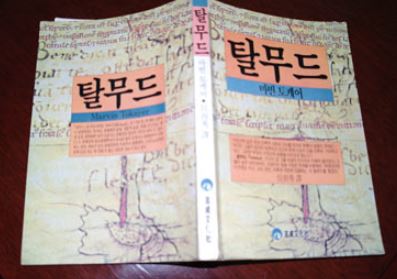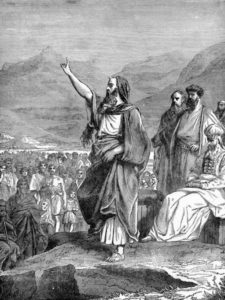
‘Moses Speaks to Israel’ by Philippoteaux (19th century)
This week we begin reading the fifth and final book of the Torah, Devarim, literally “Words”. This book is distinct from the others, for it is written from the perspective of Moses. It records Moses’ final words to the nation over his last 37 days of leadership. Devarim serves, in many ways, as a summary of the Torah, and is therefore traditionally referred to as Mishneh Torah, a “repetition” of the Torah. In fact, when our ancient Sages first translated the Torah into Greek (at the behest of King Ptolemy), they called the book Deuteronomion, “repeated law”, ie. the Greek translation for Mishneh Torah. Having said that, Deuteronomy introduces a number of new mitzvot previously unmentioned in the Torah, and contains some of the Torah’s most significant passages, including the Shema and Ha’azinu.
The reader will quickly notice that Deuteronomy has a totally different tone from the rest of the Torah. Its language is far more similar, not to the books of Torah that precede it, but to the books of Tanakh that follow it: Joshua, Judges, Samuel, and Kings. (Secular scholars actually combine these books and label them the “Deuteronomistic history”.) Thus, the fifth book of the Torah plays a critical function: it concludes the Five Books of Moses while simultaneously introducing and segueing into the rest of the Tanakh. One who reads the conclusion of Deuteronomy and immediately starts Joshua will hardly notice that they’ve changed books. For instance, the former ends with Moses telling Joshua to be chazak v’ematz, “strong and brave” (Deuteronomy 31:7, 23), while the latter picks up with the same exact phrase multiple times (Joshua 1:6, 7, 9, 18).
This signifies the fluid, continuous chain of transmission, starting with Moses, passing on directly to Joshua, then the Elders, down through the rest of the Prophets, to the Men of the Great Assembly, and to the Sages that followed (Avot 1:1), up to the rabbis of the present day. Herein lies the true purpose of Deuteronomy: it holds together all of Judaism, including both the “Written” and “Oral” Torah. We may think of Deuteronomy as “Written”, but a careful reading shows that it is quite clearly more “Oral” in nature. One of the most puzzling things about it is that with all of the key narratives that it repeats, it appears to change the details!
For example, in the Ten Commandments recorded in Exodus, Shabbat is to commemorate the world’s Creation in six days, and God’s resting on the seventh (Exodus 20:11). In the Ten Commandments of Deuteronomy, however, Shabbat is to commemorate that God took us out of Egypt and we are no longer slaves who must work around the clock (Deuteronomy 5:15). Which is it? Another example is the Sin of the Spies: in Numbers 13 we read that God commanded to send spies to scout the Holy Land; in Deuteronomy 1:22, it is the people themselves that request it of Moses. What was it? Even more problematic, in Deuteronomy 10:6, Aaron dies in a different place and at a different time than that presented in Numbers 33:38! How do we make sense of these discrepancies?
The classic answer is that Deuteronomy is Moses’ own recollection of past events. After all, the book begins by saying Eleh hadevarim asher diber Moshe—these were specifically the words of Moses himself. The Zohar (III, 261a) says that unlike the rest of the Torah which was dictated to Moses by God, “Mishneh Torah was spoken from Moses’ own mouth” (משנה תורה משה מפי עצמו אמרן). As such, included within it were Moses’ own interpretations of the Torah and the law. And this, therefore, serves as the foundation for the entire Oral Tradition. Moreover, this is why we always refer to Moses as Moshe Rabbeinu, “Moses our rabbi”. He is the first rabbi, the first to analyze and interpret the Torah, extracting its deeper meanings and uncovering the hidden wisdom of God buried in the plain text—in the words of the Zohar, the chokhmah ila’ah (חכמה עלאה) buried inside.
The Zohar concludes that Deuteronomy is the Oral Torah! It is from Deuteronomy that we learn about the need to interpret the Torah and extract the wisdom within it. The Zohar adds that this is why the Ten Commandments in Deuteronomy have a seemingly superfluous vav before them (וְלֹ֣֖א תִּֿנְאָ֑͏ף׃ וְלֹ֣֖א תִּֿגְנֹֽ֔ב׃ וְלֹֽא־תַעֲנֶ֥ה) whereas the Ten Commandments in Exodus do not (לֹ֣֖א תִּֿנְאָ֑͏ף׃ לֹ֣֖א תִּֿגְנֹֽ֔ב׃ לֹֽא־תַעֲנֶ֥ה). The extra vav, which means “and”, serves to teach that this is the command and, hidden inside, all the other additional laws one can extract from it! The Zohar gives an example: In Exodus we are told only not to covet a fellow’s wife (לֹֽא־תַחְמֹ֞ד אֵ֣שֶׁת רֵעֶ֗ךָ), but in Deuteronomy we are told not to covet and not to crave (וְלֹ֥א תַחְמֹ֖ד אֵ֣שֶׁת רֵעֶ֑ךָ וְלֹ֨א תִתְאַוֶּ֜ה). Rabbi Yose explains that based on Exodus alone one might think the law is only not to actually abduct a woman, or conspire to do so, but from Deuteronomy we further learn that one is forbidden from even craving another, whether in thought or desire, even without acting on it. The Zohar gives other examples, showing how the purpose of Deuteronomy is actually to extract the true meaning of the previous four books of the Torah.
In that case, Moses the rabbi was the first to reinterpret the Torah and extract new layers of meaning from it. It is in Deuteronomy that he lays out the rabbinic system, and in Deuteronomy that the 613 mitzvot of the Torah are completed. Beautifully, the numerical value of Moshe Rabbeinu (משה רבינו) is 613. It has further been pointed out that the system Moses laid out in Deuteronomy, relayed specifically over his last 37 days, correspond to the 37 tractates of Talmud, solidifying the link. So, we see that Deuteronomy accomplishes two things: first, weaving smoothly into the rest of the Tanakh, and second, bridging to the Oral Torah. It is no coincidence that the first official written work of Oral Torah is called the Mishnah, a direct link to Moses’ Mishneh Torah.
With this in mind, there is truly little room to distinguish between “Written” and “Oral” Torah at all. The two are inseparable and intertwined, like the branches of the Tree of Life (to paraphrase the poetic words of the Zohar). The Oral Torah begins in Deuteronomy, and flows through the rest of the Tanakh, before being fleshed out in fuller form in the Mishnah, then the Talmud. There is a continuous historical, chronological, legal, linguistic chain of development. (If considering the ‘Nakh as “Oral Torah” seems strange and counterintuitive, keep in mind how the Samaritans—who deny an Oral Torah—only hold Moshe’s Torah as holy, and have no ‘Nakh at all! They reject the Prophets basically the same way they reject the Talmud!)
It is worth adding one more point here: the first person to actually codify the entire Torah, both “Written” and “Oral”, was the Rambam, Rabbi Moshe ben Maimon (1138-1204), “Maimonides”. As the famous saying goes, “from Moshe to Moshe there arose no one like Moshe”, ie. since Moshe Rabbeinu there was none as great as Moshe ben Maimon. In some ways, he completed the Torah process that began at Sinai—at least its legal portion. He summarized and codified all of Jewish law, clearly and succinctly, in a 14-volume masterpiece that he called, not coincidentally, the Mishneh Torah. It remains the only complete code of Jewish law, that covers all aspects of Torah and Judaism. In his introduction, the Rambam boldly states that no other code is required and, quite incredibly, that a person who wants to understand all of Judaism need only read the Torah, and his Mishneh Torah!
For this (among other things), the Rambam was heavily criticized. He sought to set in stone Jewish law, but Jewish law is not meant to be set in stone. Even the Ten Commandments that were literally set in stone in Exodus were already interpreted differently by Moshe Rabbeinu in Deuteronomy! Jewish law must remain alive and breathing, changing, growing, adapting with the times.
One might ask: if that’s the case, why did Moses say not to add or remove anything from his Torah? (Deuteronomy 4:2) At the same time, he said to listen to the future rulings of the Torah leaders that arise in each generation, and not to veer “right or left” from their decrees (Deuteronomy 17:11). Throughout history, many solutions have been presented to this problem. One way to understand it is to remember that, in Deuteronomy, Moses is speaking to the soul of each individual Jew. The other four books of the Torah were God’s Word to the nation as a whole. Deuteronomy is Moses’ word to his people, to each person. Thus, in the same way that he says each person should listen to the consensus of the Torah authorities (17:11), so too should each person not add or remove anything from the Torah of their own accord (4:2). Only a recognized majority body of scholars could ever make critical emendations when necessary. This was indeed the case throughout the era of Prophets and the Talmud, when a Sanhedrin existed (it formally ended in the 5th century, see ‘An Eye-Opening History of the Sanhedrin’).
That brings us back to the Rambam. In his Mishneh Torah introduction, he lamented the fact that, due to our exile, individual rabbis have had to make local rulings that were subsequently adopted by others and, over the centuries, Judaism started to fracture because of it, and there was growing confusion regarding the law. The Rambam therefore sought to clarify and codify the actual, universal Jewish law, based strictly on the Torah and Talmud, the only documents that carried the authority of a Sanhedrin or other recognized majority body of scholars. He explains this all in the latter half of his introduction.
While the Mishneh Torah did not end up being the last word on Jewish law, it did launch a trend where the law needed more widespread consensus and recognition. It led to more in-depth codes of law, with more explanation, and more debate regarding the finer points of law. It led to a “virtual” Sanhedrin of sorts, where legal texts attain primacy over time through majority recognition of rabbis separated by thousands of miles. And so, Jewish law continues to evolve, adapt, and grow, as always intended by the first Moses—and the first rabbi—Moshe Rabbeinu.
Click here to read ‘The Untold Story of Napoleon and the Jews’, an excerpt from Garments of Light on Tisha b’Av.

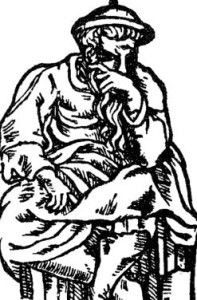


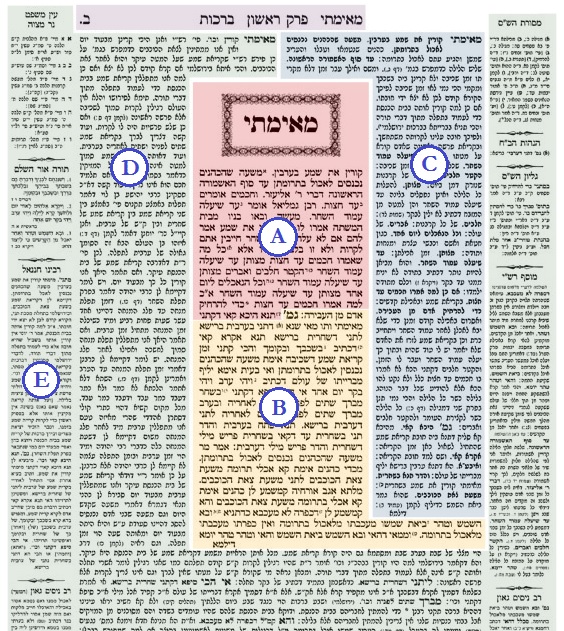
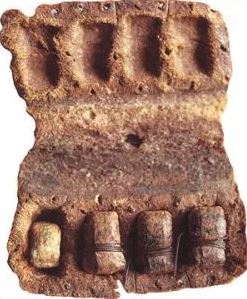
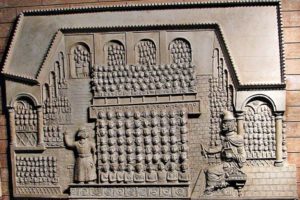
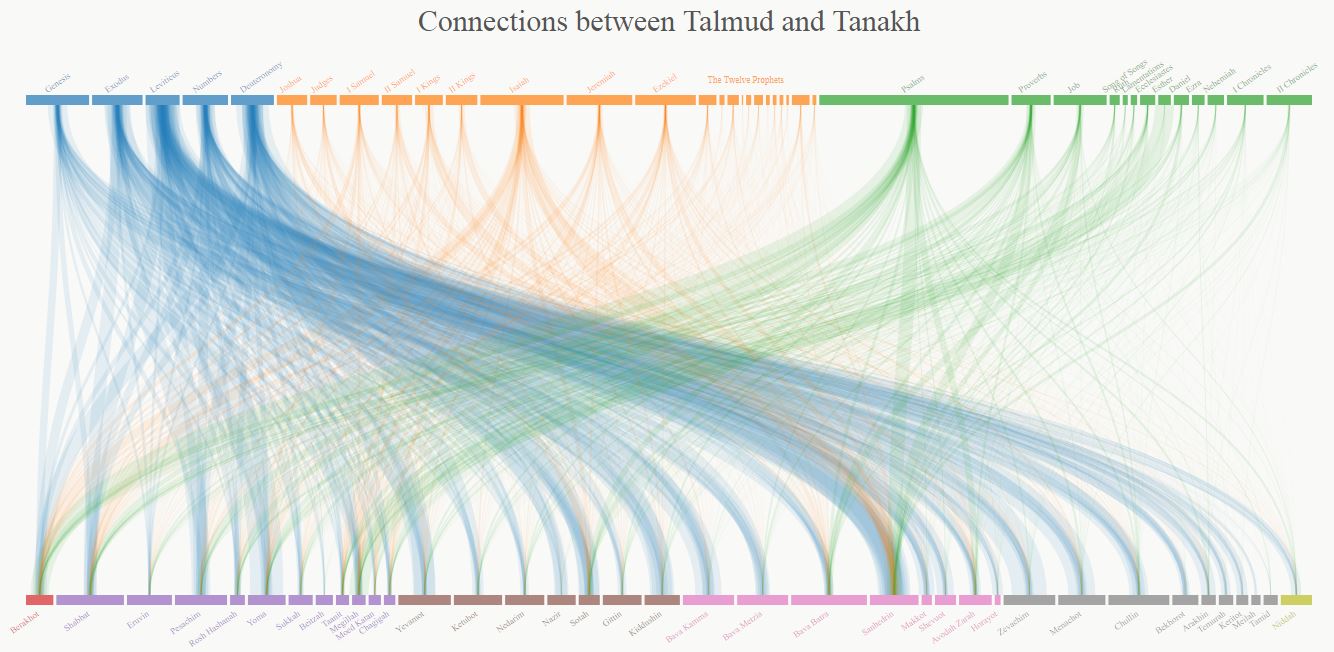
 First of all, it is important that things are kept in their historical and textual context. Secondly, it is just as important to remember that the Talmud is not the code of Jewish law. (That would be the Shulchan Arukh, and others.) The Talmud presents many opinions, including non-Jewish sayings of various Roman figures, Greek philosophers, and Persian magi. Just because there is a certain strange statement in the Talmud does not mean that its origin is Jewish, and certainly does not mean that Jews necessarily subscribe to it. Even on matters of Jewish law and custom, multiple opinions are presented, most of which are ultimately rejected. The Talmud’s debates are like a transcript of a search for truth. False ideas will be encountered along the way. The Talmud presents them to us so that we can be aware of them, and learn from them.
First of all, it is important that things are kept in their historical and textual context. Secondly, it is just as important to remember that the Talmud is not the code of Jewish law. (That would be the Shulchan Arukh, and others.) The Talmud presents many opinions, including non-Jewish sayings of various Roman figures, Greek philosophers, and Persian magi. Just because there is a certain strange statement in the Talmud does not mean that its origin is Jewish, and certainly does not mean that Jews necessarily subscribe to it. Even on matters of Jewish law and custom, multiple opinions are presented, most of which are ultimately rejected. The Talmud’s debates are like a transcript of a search for truth. False ideas will be encountered along the way. The Talmud presents them to us so that we can be aware of them, and learn from them.